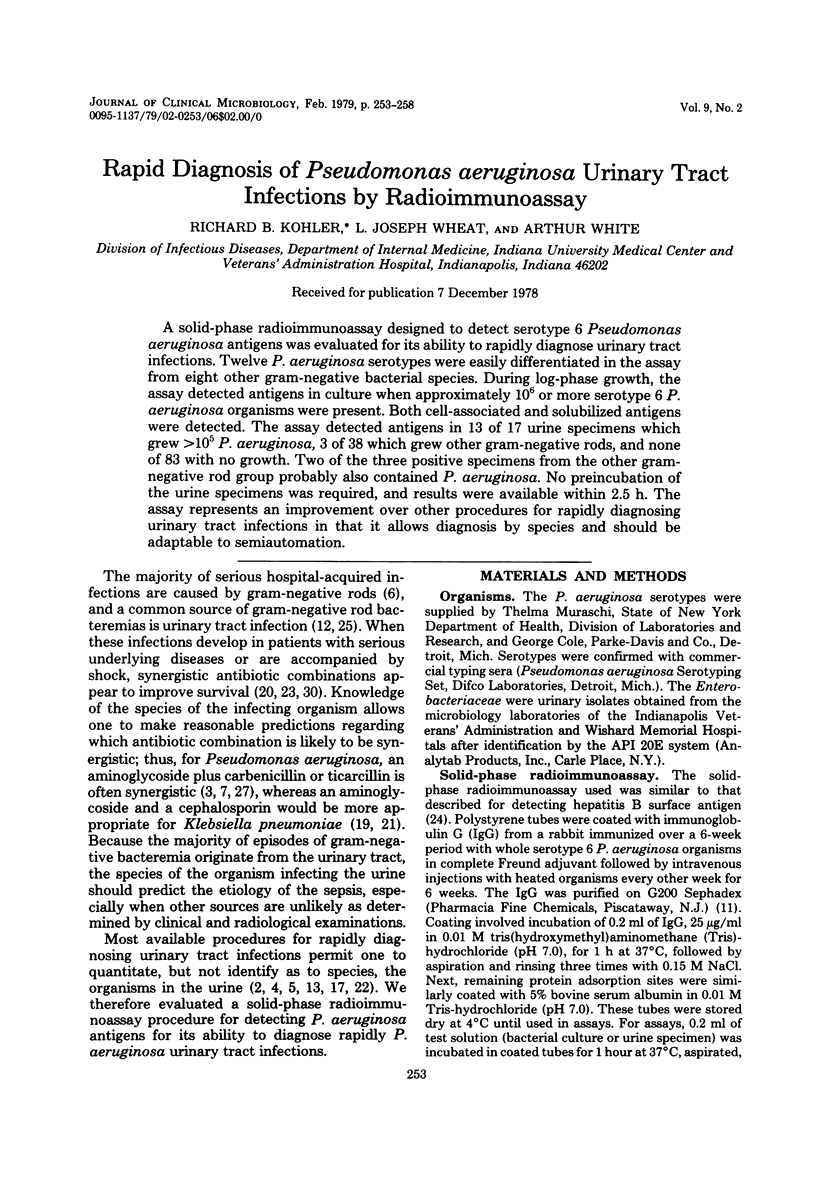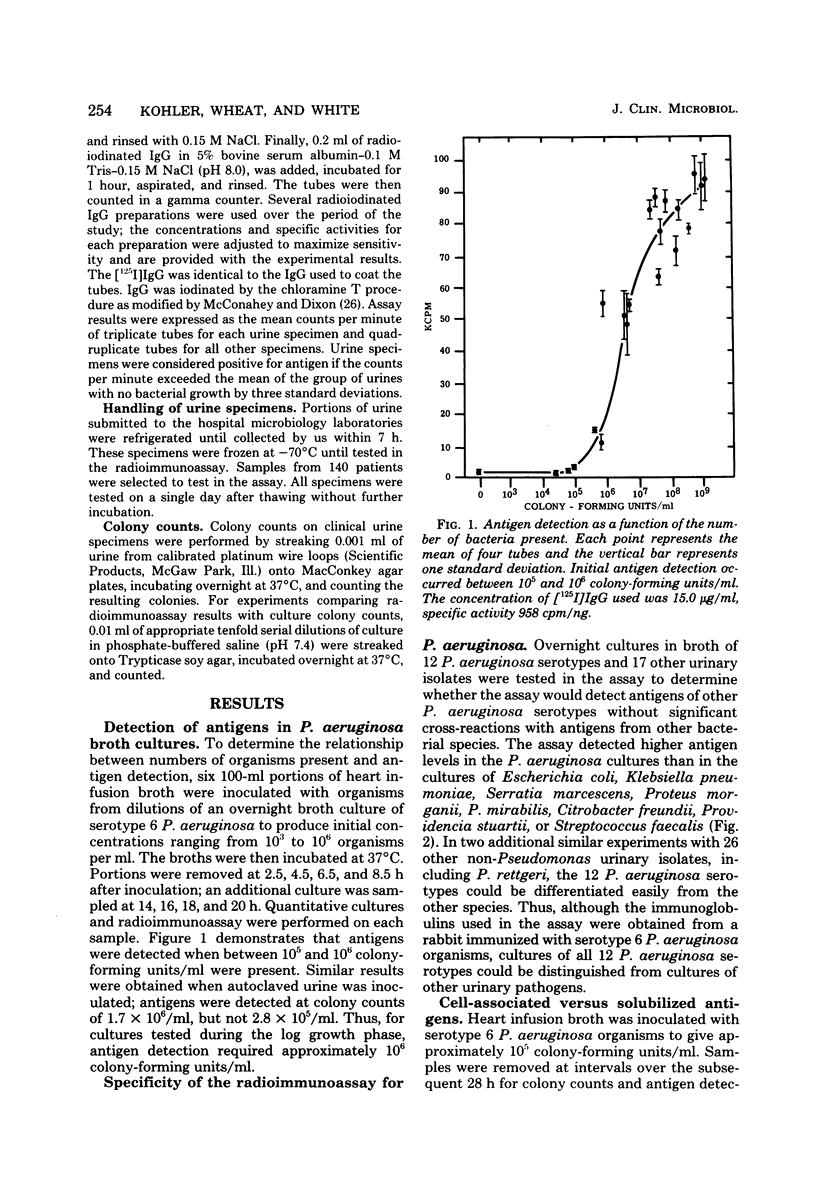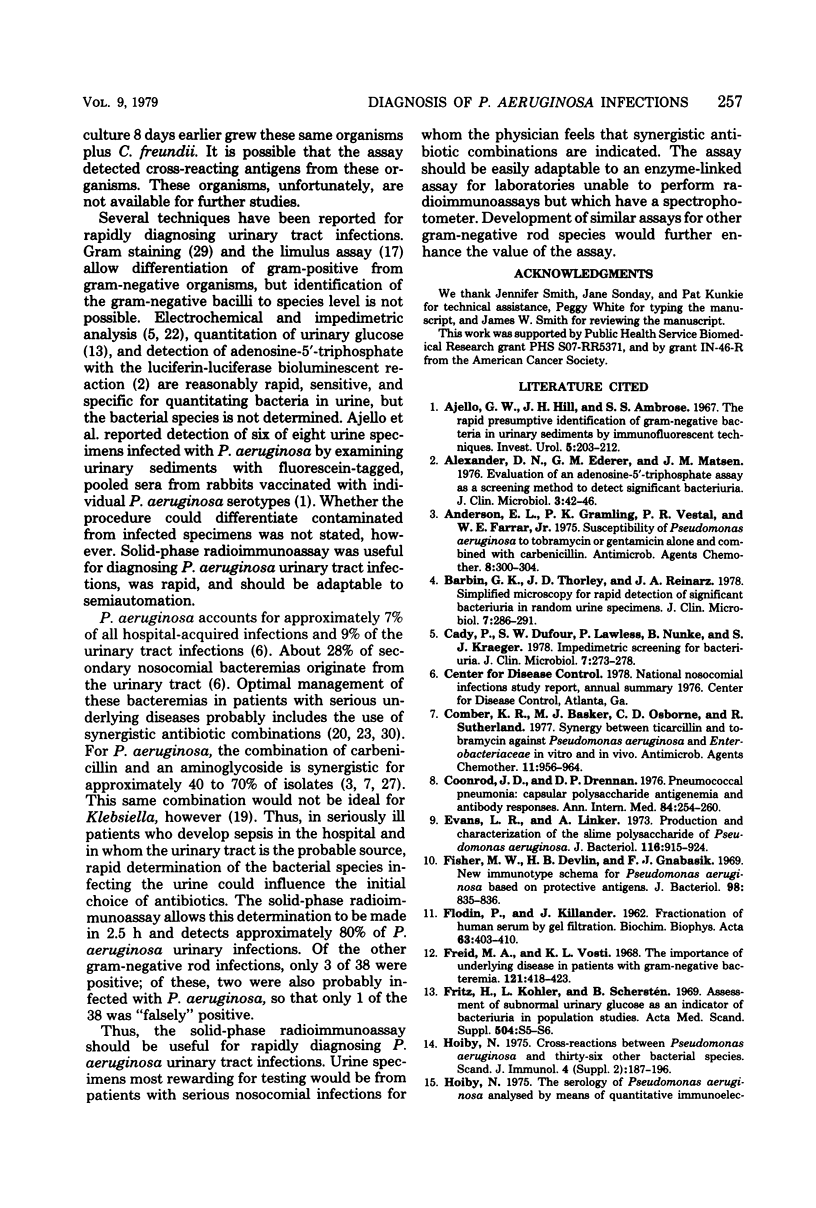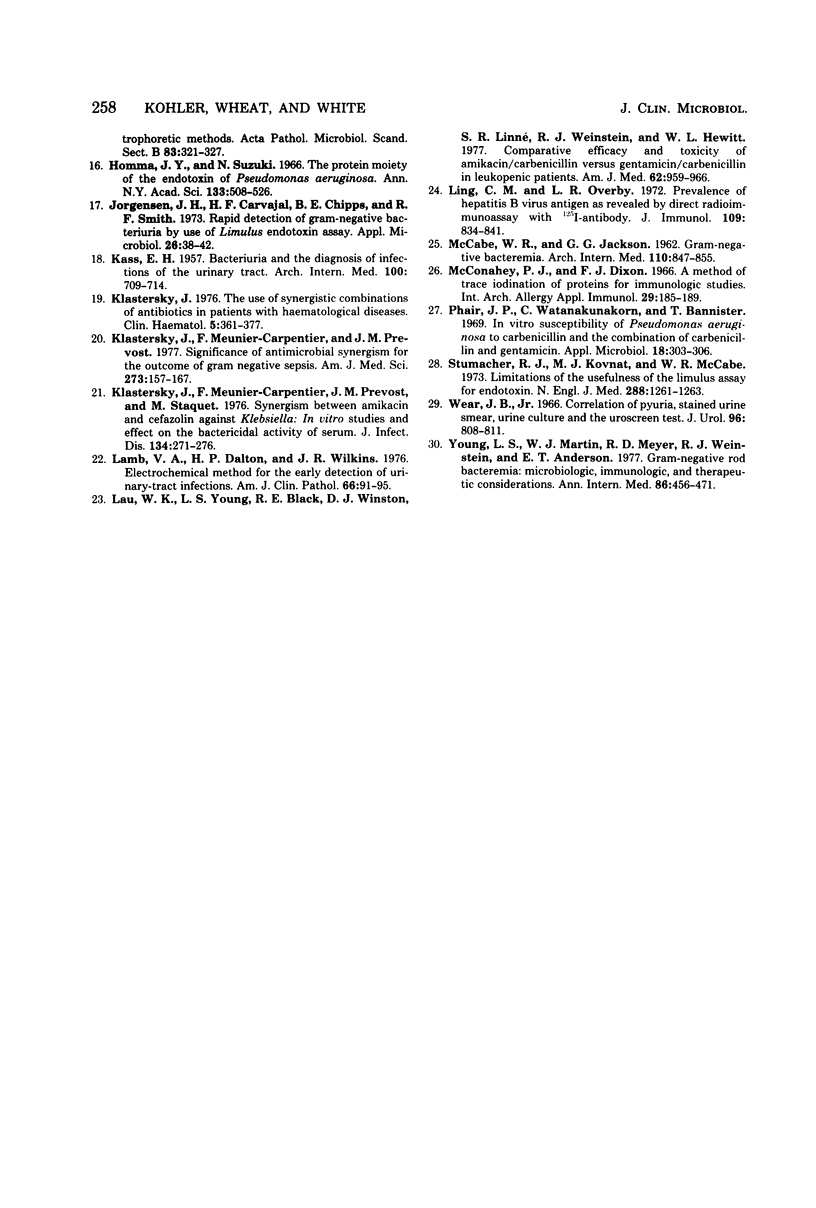Abstract
A solid-phase radioimmunoassay designed to detect serotype 6 Pseudomonas aeruginosa antigens was evaluated for its ability to rapidly diagnose urinary tract infections. Twelve P. aeruginosa serotypes were easily differentiated in the assay from eight other gram-negative bacterial species. During log-phase growth, the assay detected antigens in culture when approximately 10(6) or more serotype 6 P. aeruginosa organisms were present. Both cell-associated and solubilized antigens were detected. The assay detected antigens in 13 of 17 urine specimens which grew greater than 10(5) P. aeruginosa, 3 of 38 which grew other gram-negative rods, and none of 83 with no growth. Two of the three positive specimens from the other gram-negative rod group probably also contained P. aeruginosa. No preincubation of the urine specimens was required, and results were available within 2.5 h. The assay represents an improvement over other procedures for rapidly diagnosing urinary tract infections in that it allows diagnosis by species and should be adaptable to semiautomation.
Full text
PDF





Selected References
These references are in PubMed. This may not be the complete list of references from this article.
- Ajello G. W., Hill J. H., Ambrose S. S. The rapid presumptive identification of gram-negative bacteria in urinary sediments by immunofluorescent techniques. II. The production and initial testing of fluorescent antibody reagents for Pseudomonas aeruginosa. Invest Urol. 1967 Sep;5(2):203–212. [PubMed] [Google Scholar]
- Alexander D. N., Ederer G. M., Matsen J. M. Evaluation of an adenosine 5'-triphosphate assay as a screening method to detect significant bacteriuria. J Clin Microbiol. 1976 Jan;3(1):42–46. doi: 10.1128/jcm.3.1.42-46.1976. [DOI] [PMC free article] [PubMed] [Google Scholar]
- Anderson E. L., Gramling P. K., Vestal P. R., Farrar W. E., Jr Susceptibility of Pseudomonas aeruginosa to tobramycin or gentamicin alone and combined with carbenicillin. Antimicrob Agents Chemother. 1975 Sep;8(3):300–304. doi: 10.1128/aac.8.3.300. [DOI] [PMC free article] [PubMed] [Google Scholar]
- Barbin G. K., Thorley J. D., Reinarz J. A. Simplified microscopy for rapid detection of significant bacteriuria in random urine specimens. J Clin Microbiol. 1978 Mar;7(3):286–289. doi: 10.1128/jcm.7.3.286-289.1978. [DOI] [PMC free article] [PubMed] [Google Scholar]
- Cady P., Dufour S. W., Lawless P., Nunke B., Kraeger S. J. Impedimetric screening for bacteriuria. J Clin Microbiol. 1978 Mar;7(3):273–278. doi: 10.1128/jcm.7.3.273-278.1978. [DOI] [PMC free article] [PubMed] [Google Scholar]
- Comber K. R., Basker M. J., Osborne C. D., Sutherland R. Synergy between ticarcillin and tobramycin against Pseudomonas aeruginosa and Enterobacteriaceae in vitro and in vivo. Antimicrob Agents Chemother. 1977 Jun;11(6):956–964. doi: 10.1128/aac.11.6.956. [DOI] [PMC free article] [PubMed] [Google Scholar]
- Coonrod J. D., Drennan D. P. Pneumococcal pneumonia: capsular polysaccharide antigenemia and antibody responses. Ann Intern Med. 1976 Mar;84(3):254–260. doi: 10.7326/0003-4819-84-3-254. [DOI] [PubMed] [Google Scholar]
- Evans L. R., Linker A. Production and characterization of the slime polysaccharide of Pseudomonas aeruginosa. J Bacteriol. 1973 Nov;116(2):915–924. doi: 10.1128/jb.116.2.915-924.1973. [DOI] [PMC free article] [PubMed] [Google Scholar]
- FLODIN P., KILLANDER J. Fractionation of human-serum proteins by gel filtration. Biochim Biophys Acta. 1962 Oct 8;63:402–410. doi: 10.1016/0006-3002(62)90104-x. [DOI] [PubMed] [Google Scholar]
- Fisher M. W., Devlin H. B., Gnabasik F. J. New immunotype schema for Pseudomonas aeruginosa based on protective antigens. J Bacteriol. 1969 May;98(2):835–836. doi: 10.1128/jb.98.2.835-836.1969. [DOI] [PMC free article] [PubMed] [Google Scholar]
- Freid M. A., Vosti K. L. The importance of underlying disease in patients with gram-negative bacteremia. Arch Intern Med. 1968 May;121(5):418–423. [PubMed] [Google Scholar]
- Homma J. Y., Suzuki N. The protein moiety of the endotoxin of Pseudomonas aeruginosa. Ann N Y Acad Sci. 1966 Jun 30;133(2):508–526. doi: 10.1111/j.1749-6632.1966.tb52386.x. [DOI] [PubMed] [Google Scholar]
- KASS E. H. Bacteriuria and the diagnosis of infections of the urinary tract; with observations on the use of methionine as a urinary antiseptic. AMA Arch Intern Med. 1957 Nov;100(5):709–714. doi: 10.1001/archinte.1957.00260110025004. [DOI] [PubMed] [Google Scholar]
- Klastersky J., Meunier-Carpentier F., Prevost J. M. Significance of antimicrobial synergism for the outcome of gram negative sepsis. Am J Med Sci. 1977 Mar-Apr;273(2):157–167. doi: 10.1097/00000441-197703000-00005. [DOI] [PubMed] [Google Scholar]
- Klastersky J., Meunier-Carpentier F., Prevost J. M., Staquet M. Synergism between amikacin and cefazolin against Klebsiella: in vitro studies and effect on the bactericidal activity of serum. J Infect Dis. 1976 Sep;134(3):271–276. doi: 10.1093/infdis/134.3.271. [DOI] [PubMed] [Google Scholar]
- Klastersky J. The use of synergistic combinations of antibiotics in patients with haematological diseases. Clin Haematol. 1976 Jun;5(2):361–377. [PubMed] [Google Scholar]
- Lamb V. A., Dalton H. P., Wilkins J. R. Electrochemical method for the early detection of urinary-tract infections. Am J Clin Pathol. 1976 Jul;66(1):91–95. doi: 10.1093/ajcp/66.1.91. [DOI] [PubMed] [Google Scholar]
- Lau W. K., Young L. S., Black R. E., Winston D. J., Linne S. R., Weinstein R. J., Hewitt W. L. Comparative efficacy and toxicity of amikacin/carbenicillin versus gentamicin/carbenicillin in leukopenic patients: a randomized prospective trail. Am J Med. 1977 Jun;62(6):959–966. doi: 10.1016/0002-9343(77)90669-6. [DOI] [PubMed] [Google Scholar]
- Ling C. M., Overby L. R. Prevalence of hepatitis B virus antigen as revealed by direct radioimmune assay with 125 I-antibody. J Immunol. 1972 Oct;109(4):834–841. [PubMed] [Google Scholar]
- McConahey P. J., Dixon F. J. A method of trace iodination of proteins for immunologic studies. Int Arch Allergy Appl Immunol. 1966;29(2):185–189. doi: 10.1159/000229699. [DOI] [PubMed] [Google Scholar]
- Phair J. P., Watanakunakorn C., Bannister T. In vitro susceptibility of Pseudomonas aeruginosa to carbenicillin and the combination of carbenicillin and gentamicin. Appl Microbiol. 1969 Sep;18(3):303–306. doi: 10.1128/am.18.3.303-306.1969. [DOI] [PMC free article] [PubMed] [Google Scholar]
- Stumacher R. J., Kovnat M. J., McCabe W. R. Limitations of the usefulness of the Limulus assay for endotoxin. N Engl J Med. 1973 Jun 14;288(24):1261–1264. doi: 10.1056/NEJM197306142882402. [DOI] [PubMed] [Google Scholar]
- Wear J. B., Jr Correlation of pyuria, stained urine smear, urine culture and the uroscreen test. J Urol. 1966 Nov;96(5):808–811. doi: 10.1016/S0022-5347(17)63356-1. [DOI] [PubMed] [Google Scholar]
- Young L. S., Martin W. J., Meyer R. D., Weinstein R. J., Anderson E. T. Gram-negative rod bacteremia: microbiologic, immunologic, and therapeutic considerations. Ann Intern Med. 1977 Apr;86(4):456–471. doi: 10.7326/0003-4819-86-4-456. [DOI] [PubMed] [Google Scholar]


